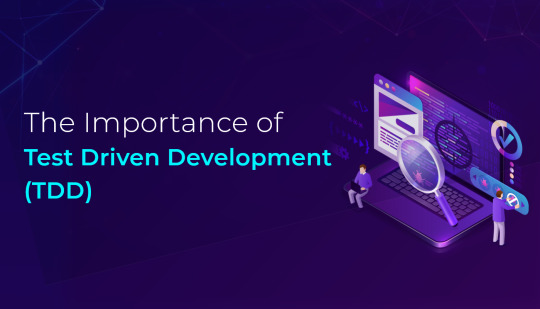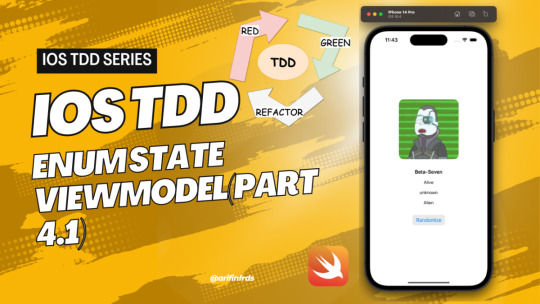#test driven development
Explore tagged Tumblr posts
Text
0 notes
Text

The Benefits of TDD
Improved code quality
Early detection of bugs
Rapid feedback loop
Simplified refactoring
Design improvement
Clearer understanding of requirements
Easier integration
Reduced debugging effort
Comprehensive test coverage
Facilitates team collaboration
Cost-efficient
Customer satisfaction
#technology#digital transformation#tech#mobile app developers#software development#technology trends#product development service#it consulting#TDD#test drive#test driven development
0 notes
Text
WordPress Scheduled Post: "#4 Part 4.1- iOS - TDD - Random Character App - Swift - Enable the Power of TDD to Refactor MVVM to State based MVVM"
Sometimes we want to manage State in ViewModel easier. Instead of having multiple observed properties, we can have single state property that is observed by the View. We will learn how to safely refactor our ViewModel using TDD using State based MVVM.
Sometimes we want to manage State in ViewModel easier. Instead of having multiple observed properties, we can have single state property that is observed by the View. In this video, we will learn how to safely refactor our ViewModel using TDD using State based ViewModel variation. Let’s dive in into the second part of 4th video, State base MVVM with TDD! #testdrivendevelopment #tdd #tddios…

View On WordPress
#Good Programming Practice#iOS#Ios Development#Mvvm#mvvmios#mvvmstate#Software Engineering#Test Driven Development
0 notes
Text
Oh God I'm thinking about rewriting my whole mod to be all data driven......... I already added KubeJS support I really don't have to do this, the people can already make reactions in modpacks !!
(But it'd be cool)
It would but, but...
#minecraft#minecraft mods#minecraft modding#mod development#reactive alchemy#tbh the reason I'm not doing this is probably b.c. powers need to be static (I think) and reactions need to have like behavior#so the best i could do is do what enchantments did and make like#reaction effect components that are hard coded#which#would that even be better then just “write the effect in kubejs buddy”??#idk if anyone even uses this system......#developer when no telemetry#maybe i'll make a new branch and play around with it but not add it to the mod until the next major release#i want to add like reaction items in that so changing reactions (again) would make some sense at least...#as for Powers#i test for specific powers so often#i really cant be bothered to make them data driven#despite the fact that wpuld be way easier#...#maybe...#*sigh* two branches
9 notes
·
View notes
Text
THE FIRST VERSION OF THE CODE SHOULD LOOK LIKE CRAP!
PRACTICE WRITING CRAP CODE AND FIXING IT AS A DESIGN METHOD!
IT IS CALLED TEST DRIVEN DESIGN!

#TDD#test driven design#softeware#codeblr#programming#coding#software#software developer#software development
119K notes
·
View notes
Text
A Comprehensive Guide to the Top 7 Python Testing Frameworks

In today’s fast-paced development landscape, delivering high-quality, bug-free software is a non-negotiable requirement. Whether you're developing a web app, data pipeline, or AI solution, one thing remains constant—testing is essential. And when it comes to testing in Python, developers are spoiled for choice.
Python has long been celebrated for its simplicity and versatility, making it the backbone of many industries—from web development to AI. If you're serious about reliability and continuous delivery, it’s time to explore the top Python testing frameworks dominating 2025’s development practices.
Let’s dive into the top 7 Python testing frameworks and see how they stack up in real-world development environments.
1. Pytest – The Developer Favorite
Pytest is arguably the most popular testing framework in the Python ecosystem. It’s simple, powerful, and incredibly flexible.
Key Features:
Supports unit testing, functional testing, and API testing
Fixtures for complex setup
Plugins like pytest-django, pytest-cov, and more
Ideal for both beginners and seasoned developers, Pytest is often the top choice when you hire Python developers to build robust web or software applications.
2. Unittest (Built-in) – Python’s Native Test Framework
Inspired by Java’s JUnit, Unittest is Python’s standard testing library. While it's not as flashy or feature-rich as Pytest, it's perfect for developers who prefer sticking to built-in modules.
Key Features:
Test discovery
Test fixtures (setUp, tearDown)
Supports test automation in CI/CD environments
For teams new to testing, this is often the starting point before moving to more advanced frameworks.
3. Behave – Behavior-Driven Development (BDD)
Behave enables Behavior-Driven Development, allowing teams to write human-readable tests in the "Given-When-Then" format.
Key Features:
Great for cross-functional collaboration
Gherkin syntax support
Ideal for user journey or acceptance testing
Startups and enterprises alike choose Behave when they hire dedicated Python developers to build user-centric applications with business logic validation at every step.
4. Nose2 – Successor to Nose
While the original Nose is no longer actively maintained, Nose2 is here to pick up the torch. It's compatible with unittest and offers more plugins and improved extensibility.
Key Features:
Automatic test discovery
Plugins for test coverage, parallel testing, and more
Supports legacy Nose tests
Nose2 is perfect for teams transitioning from older testing ecosystems or managing large-scale test suites.
5. Robot Framework – For Acceptance Testing
Robot Framework is a keyword-driven testing tool perfect for acceptance testing and robotic process automation.
Key Features:
Supports Selenium, API testing, database testing
Human-readable syntax
Integrates with Python libraries
It's widely used in enterprise environments and often seen in projects managed by a mature Python development company.
6. Testify – Scalable Testing for Large Codebases
Testify is a modern, feature-rich alternative to unittest and Nose, designed with scalability and readability in mind.
Key Features:
Class-based test organization
Built-in assertion methods
Clean API for large-scale development
For companies scaling their operations, Testify offers a neat balance of power and readability. It’s a good option for teams using Python for modern software development.
7. Tox – Testing Across Environments
Tox isn’t a test runner in itself but a tool that automates testing in different Python environments. It’s indispensable for Python library authors or those managing multiple versions.
Key Features:
Test automation for different Python versions
Dependency management
Seamless CI/CD integration
Tox is especially useful when paired with other frameworks like Pytest or Unittest, ensuring your code is compatible across all Python environments.
How to Choose the Right Framework?
Choosing the right Python testing framework depends on:
Project size and complexity
Team skill level
Framework support and community
Integration with CI/CD tools and third-party services
If your business is investing in Python, the smart move is to hire Python developers who are proficient in one or more of these frameworks and can align with your development goals.
Why Testing Frameworks Matter in Modern Development
With the growing demand for faster delivery and fewer bugs, adopting structured testing processes has become standard practice. Testing ensures stability, increases confidence in releases, and accelerates development cycles.
Modern frameworks also enable:
Continuous Integration/Delivery (CI/CD) pipelines
Test-driven development (TDD)
Behavior-driven development (BDD)
Cross-platform compatibility checks
The developers you choose must align with these practices—an experienced Python development company will already have these workflows baked into their development culture.
Closing Thoughts
In 2025, the role of Python in shaping digital products continues to grow—from web platforms and enterprise solutions to AI-driven software. To keep up with this momentum, testing must be at the heart of every project.
Whether you're enhancing your development pipeline, scaling your startup, or modernizing enterprise systems, these frameworks will guide your way. But tools are only as good as the hands that wield them.
Make the right choice—hire dedicated Python developers who understand the importance of quality and know how to integrate these tools effectively.
For those beginning their journey, here’s a solid starting point: our Guide to Python for Web Development and Python: The Top Frameworks & Best Practices blog series cover everything you need to build stable, scalable applications.
Need help with your next project? Tuvoc Technologies offers expert Python development services tailored for today’s software landscape. Let’s build something exceptional—together.
#Python#PythonProgramming#PythonDev#Coding#SoftwareDevelopment#PythonTesting#TestAutomation#UnitTesting#SoftwareTesting#QAEngineer#PyTest#Unittest#TDD (Test-Driven Development)#DevTips#CodeQuality
0 notes
Text
The Botfly Test: Characterizing parasitic automated behavior in online communities

I recently encountered non-transparent automated behavior in a tech-community forum, and it really, really annoyed me. After confirming that my spidey senses were correct, and that this user was actively, regularly, and non-transparently performing and benefiting from automated interactions in the forum, I spent some time trying to figure out why exactly I was so annoyed by it. I came up with a basic set of Bechdel Test-style criteria for determining if specific automated behavior (i.e., bot activity) is obnoxious within the community it inhabits. The Botfly Test provides minimum standards for demonstrating prosocial community behavior. A bot that passes this test isn’t necessarily of benefit to the community, but a bot that fails this test definitely isn’t.
1 note
·
View note
Text
Test-Driven Development: Unlocking the Key to Clean and Maintainable Code

In the fast-paced world of software development, delivering high-quality code quickly is more critical than ever. Yet, according to a Consortium for IT Software Quality study, the cost of poor software quality in the US alone exceeded $2 trillion in 2022. Bugs that slip through the cracks during development can lead to skyrocketing costs, frustrated users, and even catastrophic system failures.
This is where Test-Driven Development (TDD) comes in—a methodical approach that flips traditional coding on its head by prioritizing testing before development. More than just a coding practice, TDD is a philosophy that fosters clean, reliable, and scalable software. But why does it matter so much? And how can it transform the way we build software today?
Let’s explore how TDD is reshaping development and why it should be essential to your workflow.
What is Test-Driven Development?
Test-Driven Development (TDD) is a software development methodology that emphasizes writing tests before writing the actual code. By flipping the traditional approach, TDD ensures that every piece of code serves a specific purpose and works as intended right from the start. At its core, TDD follows a simple yet powerful mantra: Red, Green, Refactor.
Key Principles: The Red, Green, Refactor Cycle
Red: Write a test for a specific functionality. Since the functionality doesn’t exist yet, the test will fail—indicated by a red signal.
Green: Write the minimum amount of code needed to pass the test. This phase ensures the test turns green, signifying that the functionality works.
Refactor: Improve the code’s structure and readability without changing its behavior. The test acts as a safety net, ensuring nothing breaks during optimization.
This cycle is repeated for every new feature or piece of functionality, promoting incremental and iterative development.
How TDD Differs from Traditional Development
Traditional Development: Developers typically write code first, then create tests afterward (if tests are written at all). This often leads to testing being deprioritized or skipped entirely.
TDD Approach: Testing is integral to the process, not an afterthought. Tests define the functionality before any code is written, ensuring clarity and purpose.
TDD fosters a test-first mindset, reducing the risk of errors and encouraging the development of modular, maintainable code. Unlike traditional methods, TDD makes debugging easier and provides immediate feedback on whether the code meets its requirements.
By championing these principles, TDD lays a strong foundation for robust software development, offering benefits that extend beyond just code quality.
Benefits of Test-Driven Development (TDD)
Test-Driven Development offers a wealth of advantages that extend beyond just testing and coding. By integrating TDD into your development process, you can achieve better software quality, seamless collaboration, and greater confidence in your codebase. Here’s a closer look at its key benefits:
1. Improved Code Quality: TDD emphasizes writing clean, modular, and testable code. Since every piece of functionality is driven by pre-written tests, the resulting code is often more structured and easier to maintain. Developers are also encouraged to break down complex problems into smaller, manageable components, leading to a more robust and scalable codebase.
2. Early Detection of Bugs: Detecting and addressing defects early in the development cycle can significantly reduce costs. A 2020 study by the Systems Sciences Institute found that fixing a bug during the testing phase costs 10 times more than addressing it during development. With TDD, tests are written upfront, making it easier to identify and resolve potential issues before they escalate.
3. Better Collaboration: TDD fosters alignment between developers, testers, and other stakeholders by clearly defining functionality through tests. These tests serve as a shared understanding of requirements, bridging the gap between development and QA teams. As a result, the entire team works cohesively toward a common goal.
4. Confidence in Refactoring: One of the biggest challenges in software development is refactoring code without unintentionally breaking existing functionality. TDD alleviates this concern by providing a safety net of tests. Developers can confidently refactor, knowing that the tests will immediately flag any regressions or inconsistencies.
5. Documentation by Tests: In TDD, the tests themselves act as living documentation for the code. Unlike traditional documentation, which can quickly become outdated, TDD’s test cases reflect the current state of the codebase. They describe how the code should behave, making it easier for new team members to understand the system.
By embracing TDD, development teams can enjoy not only better code but also smoother workflows, reduced technical debt, and higher overall productivity. It’s a win-win for developers and stakeholders alike.
Challenges of Adopting Test-Driven Development (TDD)
While Test-Driven Development offers numerous benefits, its adoption comes with challenges that teams must navigate to unlock its full potential. Here are some common hurdles organizations face when implementing TDD:
1. Steeper Learning Curve for Teams New to TDD: For developers and teams unfamiliar with TDD, the methodology can initially feel counterintuitive. Writing tests before code, adhering to the Red-Green-Refactor cycle, and maintaining test coverage require a shift in mindset. This learning curve may lead to slower progress at the beginning as teams adapt to the new workflow.
2. Perceived Increase in Initial Development Time: TDD often requires developers to spend more time upfront writing tests, which may give the impression of slower development. Teams might feel pressure to meet deadlines and perceive TDD as a roadblock. However, the time invested in writing tests early often pays off in the long run by reducing bugs and minimizing rework.
3. Possible Resistance from Developers Unfamiliar with the Approach: Change can be challenging, especially when it requires breaking long-standing habits. Developers accustomed to traditional coding methods may resist adopting TDD, viewing it as an unnecessary or overly rigid process. Overcoming this resistance requires leadership support, training, and clear communication of TDD’s long-term benefits.
How to Overcome These Challenges?
Training and Resources: Provide workshops, tutorials, and mentoring to ease the learning process.
Gradual Implementation: Start with small projects or critical features to demonstrate TDD’s value without overwhelming the team.
Leadership Advocacy: Encourage leadership to champion TDD and emphasize its role in achieving long-term success.
Though the road to TDD adoption may be challenging, the payoff in code quality, team collaboration, and reduced technical debt makes the effort worthwhile.
Test-Driven Development is more than just a development methodology—it’s a mindset that prioritizes quality, collaboration, and confidence in code. By writing tests before implementation, teams can produce cleaner, more maintainable software while minimizing costly bugs and improving overall efficiency.
While adopting TDD may come with its challenges, the long-term benefits far outweigh the initial learning curve. It empowers developers to refactor confidently, aligns teams around clear requirements, and even provides living documentation for the codebase.
If you're looking to elevate your development process and create reliable, scalable software, TDD is a practice worth investing in. Ready to take the leap?
#Test-Driven Development#How TDD Differs from Traditional Development#Benefits of Test-Driven Development (TDD)#Challenges of Adopting Test-Driven Development (TDD)
0 notes
Text
The Real Darkness in Dark Fantasy: The Human Heart
Blood, blades, and betrayal might draw readers to dark fantasy. But it’s the quiet moments – the internal struggles, the fraying of conscience, the tested loyalties – that truly hook us. When done right, character depth transforms dark fantasy from mere violence into a profound exploration of human nature. Soren’s Transformation in Guild of Assassins Consider how my novel Guild of Assassins…
#character development#character growth#character-driven narratives#dark fantasy#dark fantasy relationships#dark fantasy themes#emotional depth#fantasy storytelling#grimdark fantasy#Guild of Assassins#internal conflict#internal struggles#Joe Abercrombie#Mark Lawrence#Moral Complexity#psychological battles#Robin Hobb#Soren character arc#tested loyalties
0 notes
Text
#agile development#backend development#conclusion#continuous deployment#continuous integration#deployment#designing#DevOps#DevOps engineer#documentation#FAQs#frontend development#introduction#lean development#maintenance#product manager#Programming Languages#quality assurance engineer#requirement analysis#scrum master#software development#software development jobs#software development life cycle#software engineer#test-driven development#testing#types of software development#user documentation#what is software development
0 notes
Text

What is Cucumber in software testing? Cucumber is an open-source software testing tool written in Ruby. Cucumber enables you to write test cases that anyone can easily understand regardless of their technical knowledge. Embark on your Software Automation Testing industry journey by enrolling in the GROTECHMINDS software testing cucumber, cucumber framework ,cucumber software , bdd cucumber framework ,BDD framework in selenium, cucumber software testing Courses.
#cucumber framework in selenium#bdd framework#cucumber framework#cucumber software#bdd cucumber framework#BDD framework in selenium#cucumber software testing#cucumber framework testing#cucumber behaviour driven development
0 notes
Text
4 Part 4 - iOS - TDD - Random Character App - MVVM ViewModel
In this video, we will learn how we can build our ViewModel component using Test Driven Development approach! Let's dive in into the 4th part, MVVM with TDD!
In this new series, we will be learning how we can use Test Driven Development on a networking based iOS project app, and in this case, we will fetch random character from `rickandmortyapi` and display it to the screen! In this video, we will learn how we can build our ViewModel component using Test Driven Development approach! Let’s dive in into the 4th part, MVVM with…
youtube
View On WordPress
#arifinfrds#iOS#Ios Development#iOS Unit Testing#Mobile Architecture#Mvvm#Mvvm Ios#Software Architecture#software developer#Software Development#Software Engineer#Test Driven Development#test driven development swift#testdrivendevelopment#Youtube
0 notes
Text
Writing References: Plot
Basics: Plot Structure & Narrative Arcs
Basics: Plot & Other Elements of Creative Writing
Plot Methods: Save the Cat! ⚜ The Story Circle
Plot Development: The Transformation Test
Plot-Driven Story ⚜ Plotting a Novel ⚜ Plot-Planning Worksheet
Plot Twists ⚜ Types of Plot Twists ⚜ Subplots
Ten Story Genres ⚜ Elements of the 10 Story Genres
The 3-Act Structure: History & Elements ⚜ A Guide
The Shape of Story ⚜ The Shapes of Stories by Kurt Vonnegut
Tips
From Margaret Atwood ⚜ From Rick Riordan
Before Writing your Novel ⚜ Burying Information
How to Get "Unstuck" when Writing your Novel
Editing
Chapter Maps ⚜ Editing your Own Novel
Plot Holes & Other Structural Issues ⚜ Structural Edit
Self-Editing ⚜ Novel Editing
For Inspiration
Archetypal Narrative Arcs ⚜ Character & Literary Tropes
Snowflake Method ⚜ Ways to Generate an Idea
More References: Character Development ⚜ World-building
Writing Resources PDFs
#writing tips#plot#writing advice#writeblr#writing reference#dark academia#spilled ink#literature#writing prompt#creative writing#fiction#writers on tumblr#story#writing resources#novel#light academia#compilation requested by anon#will update every few weeks/months maybe
4K notes
·
View notes
Text

m have a best AI, ML & Block chain development service company USA. Our Artificial Intelligence technologies usher in a new era of intelligent breakthroughs, unlock boundless discoveries, and improve human potential.
#SERP Advertising with AI#AI or ML driven mobile app#AI/ML Development Company#AI in performance testing#Benefits of Ai in performance testing
0 notes
Text
"Morningside Park, a beloved neighborhood park in Miami with sweeping views of Biscayne Bay, will soon pilot an innovative approach to coastal resilience.
BIOCAP tiles, a 3D-printed modular system designed to support marine life and reduce wave impact along urban seawalls, will be installed on the existing seawall there in spring 2025. BIOCAP stands for Biodiversity Improvement by Optimizing Coastal Adaptation and Performance.
Developed by our team of architects and marine biologists at Florida International University, the uniquely textured prototype tiles are designed to test a new approach for helping cities such as Miami adapt to rising sea levels while simultaneously restoring ecological balance along their shorelines...
Ecological costs of traditional seawalls
Seawalls have long served as a primary defense against coastal erosion and storm surges. Typically constructed of concrete and ranging from 6 to 10 feet in height, they are built along shorelines to block waves from eroding the land and flooding nearby urban areas.
However, they often come at an ecological cost. Seawalls disrupt natural shoreline dynamics and can wipe out the complex habitat zones that marine life relies on.
Marine organisms are crucial in maintaining coastal water quality by filtering excess nutrients, pollutants and suspended particles. A single adult oyster can filter 20-50 gallons of water daily, removing nitrogen, phosphorus and solids that would otherwise fuel harmful algal blooms. These blooms deplete oxygen levels and damage marine ecosystems.
Filter-feeding organisms also reduce turbidity, which is the cloudiness of water caused by suspended sediment and particles. Less water turbidity means more light can penetrate, which benefits seagrasses that require sunlight for photosynthesis. These seagrasses convert carbon dioxide into oxygen and energy-rich sugars while providing essential food and habitat for diverse marine species.
Swirling shapes, shaded grooves

Unlike the flat, lifeless surfaces of typical concrete seawalls, each BIOCAP tile is designed with shaded grooves, crevices and small, water-holding pockets. These textured features mimic natural shoreline conditions and create tiny homes for barnacles, oysters, sponges and other marine organisms that filter and improve water quality.
The tile’s swirling surface patterns increase the overall surface area, offering more space for colonization. The shaded recesses are intended to help regulate temperature by providing cooler, more stable microenvironments. This thermal buffering can support marine life in the face of rising water temperatures and more frequent heat events driven by climate change.
Another potential benefit of the tiles is reducing the impact of waves.
When waves hit a natural shoreline, their energy is gradually absorbed by irregular surfaces, tide pools and vegetation. In contrast, when waves strike vertical concrete seawalls, the energy is reflected back into the water rather than absorbed. This wave reflection – the bouncing back of wave energy – can amplify wave action, increase erosion at the base of the wall and create more hazardous conditions during storms.
The textured surfaces of the BIOCAP tiles are designed to help diffuse wave energy by mimicking the natural dissipation found on undisturbed shorelines.
The design of BIOCAP takes cues from nature. The tile shapes are based on how water interacts with different surfaces at high tide and low tide. Concave tiles, which curve inward, and convex tiles, which curve outward, are installed at different levels along the seawall. The goal is to deflect waves away from the seawall, reduce direct impact and help minimize erosion and turbulence around the wall’s foundation.A
How we will measure success
After the BIOCAP tiles are installed, we plan to assess how the seawall redesign enhances biodiversity, improves water quality and reduces wave energy. This two-year pilot phase will help assess the long-term value of ecologically designed infrastructure.
To evaluate biodiversity, we will use underwater cameras to capture time-lapse imagery of the marine life that colonizes the tile surfaces. These observations will aid in documenting species diversity and habitat use over time...
In the coming year, we’ll be watching with hope as the new BIOCAP tiles begin to welcome marine life, offering a glimpse into how nature might reclaim and thrive along our urban shorelines.
#ocean#seawall#florida#miami#climate adaptation#coastline#united states#north america#biodiversity#waves#ocean waves#good news#hope
926 notes
·
View notes
Text
Behavioural Test Driven Development Tools
ClearSky provides powerful Behavioural Test Driven Development (BDD) tools that create a shared understanding of requirements between business and technical stakeholders. Achieve better alignment, improve development efficiency, and reduce the risk of project delays with our advanced BDD tools. With ClearSky, you can ensure higher-quality software that meets business needs and exceeds customer expectations.
0 notes